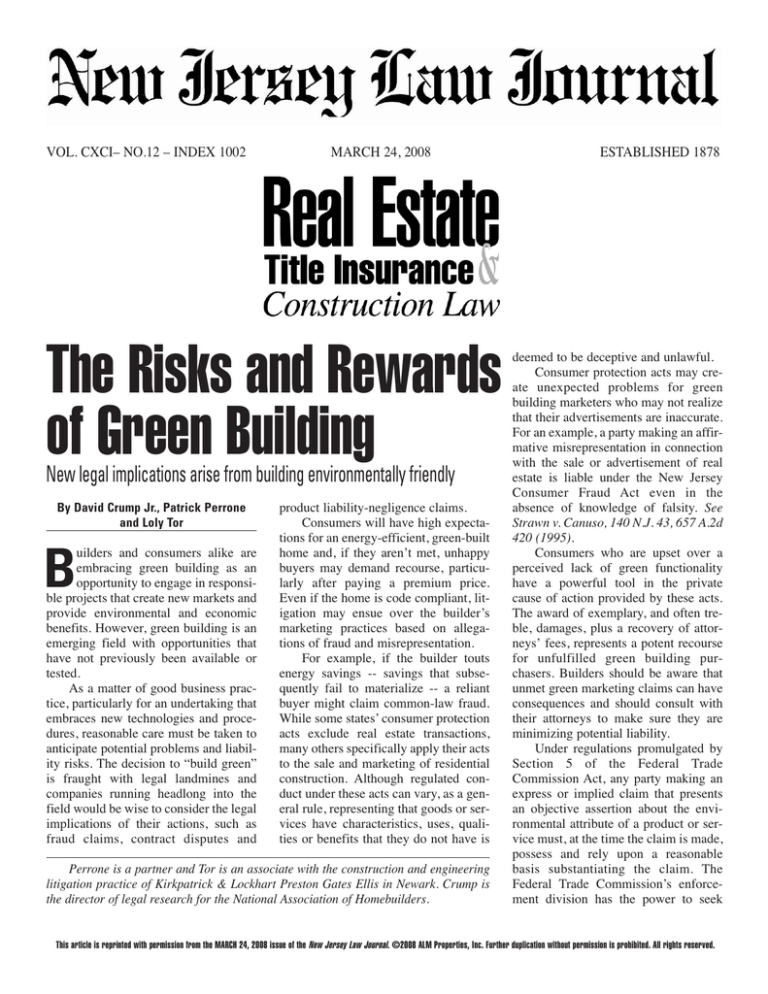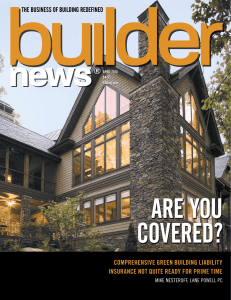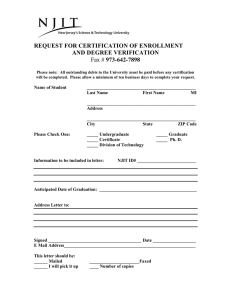
VOL. CXCI– NO.12 – INDEX 1002
MARCH 24, 2008
The Risks and Rewards
of Green Building
New legal implications arise from building environmentally friendly
By David Crump Jr., Patrick Perrone
and Loly Tor
uilders and consumers alike are
embracing green building as an
opportunity to engage in responsible projects that create new markets and
provide environmental and economic
benefits. However, green building is an
emerging field with opportunities that
have not previously been available or
tested.
As a matter of good business practice, particularly for an undertaking that
embraces new technologies and procedures, reasonable care must be taken to
anticipate potential problems and liability risks. The decision to “build green”
is fraught with legal landmines and
companies running headlong into the
field would be wise to consider the legal
implications of their actions, such as
fraud claims, contract disputes and
B
product liability-negligence claims.
Consumers will have high expectations for an energy-efficient, green-built
home and, if they aren’t met, unhappy
buyers may demand recourse, particularly after paying a premium price.
Even if the home is code compliant, litigation may ensue over the builder’s
marketing practices based on allegations of fraud and misrepresentation.
For example, if the builder touts
energy savings -- savings that subsequently fail to materialize -- a reliant
buyer might claim common-law fraud.
While some states’ consumer protection
acts exclude real estate transactions,
many others specifically apply their acts
to the sale and marketing of residential
construction. Although regulated conduct under these acts can vary, as a general rule, representing that goods or services have characteristics, uses, qualities or benefits that they do not have is
Perrone is a partner and Tor is an associate with the construction and engineering
litigation practice of Kirkpatrick & Lockhart Preston Gates Ellis in Newark. Crump is
the director of legal research for the National Association of Homebuilders.
ESTABLISHED 1878
deemed to be deceptive and unlawful.
Consumer protection acts may create unexpected problems for green
building marketers who may not realize
that their advertisements are inaccurate.
For an example, a party making an affirmative misrepresentation in connection
with the sale or advertisement of real
estate is liable under the New Jersey
Consumer Fraud Act even in the
absence of knowledge of falsity. See
Strawn v. Canuso, 140 N.J. 43, 657 A.2d
420 (1995).
Consumers who are upset over a
perceived lack of green functionality
have a powerful tool in the private
cause of action provided by these acts.
The award of exemplary, and often treble, damages, plus a recovery of attorneys’ fees, represents a potent recourse
for unfulfilled green building purchasers. Builders should be aware that
unmet green marketing claims can have
consequences and should consult with
their attorneys to make sure they are
minimizing potential liability.
Under regulations promulgated by
Section 5 of the Federal Trade
Commission Act, any party making an
express or implied claim that presents
an objective assertion about the environmental attribute of a product or service must, at the time the claim is made,
possess and rely upon a reasonable
basis substantiating the claim. The
Federal Trade Commission’s enforcement division has the power to seek
This article is reprinted with permission from the MARCH 24, 2008 issue of the New Jersey Law Journal. ©2008 ALM Properties, Inc. Further duplication without permission is prohibited. All rights reserved.
2
NEW JERSEY LAW JOURNAL,MARCH 24, 2008
injunctive relief and to impose civil fines
for violations.
The FTC has published advisory
Guides for the Use of Environmental
Marketing Claims (Green Guides) that
are designed to help businesses comply
with these federal regulations. Though
there are no guarantees, marketers who
comply with the Green Guides can
expect safe harbor for their representations concerning environmental benefits.
Public hearings on a revision to the
Green Guides are currently being held to
address the new “green building” marketing language, such as the use of the
term “sustainability.” Expect the FTC to
be more active in the future regulation of
“green building” advertisements.
There is no standard meaning for
much of the new “green building” terminology and defining terms upfront in the
contract will lessen the likelihood of customer disputes. For instance, consumers
may believe that the term “sustainability” means that green building components will last longer, when in reality
some high performance materials and
systems may actually have shorter lifespans and require frequent maintenance.
The term “green building certification”
may lead to controversy, since there are
several different national and regional
certification programs with differing criteria.
Contractually promising to obtain a
green building certification is another
area of concern. Certifications are granted by independent organizations with
differing standards and guidelines and
cannot be guaranteed. Contractually
agreeing, and then failing, to obtain certification could then be actionable as a
breach of contract, even if the home is
code compliant, and even if a certificate
of occupancy has been issued.
Green building is also expected, at
least initially, to be more expensive than
standard construction, with an additional
possibility of unforeseen costs. For
example, certain green components may
be scarce and not easily obtainable without paying a premium. Special skilled
labor may be needed to install “exotic”
components. Extra work may be
required to correct installation mistakes
that can occur when unfamiliar materials
and new building techniques are used.
Extra inspections may be needed to
obtain certification or code compliance.
With all of these additional expenses,
defining who is responsible for additional costs is essential.
Additionally, there will be new classifications of delay arising from the
novelty of green building. These may
result from difficulties in obtaining special green materials, appropriate skilled
labor, an unfamiliarity among inspection officials with green building projects, installation trial and error, extra
work necessary to achieve certification
and other certification approval problems. These new classifications should
be included in the contractual definition
of excusable delay.
Finally, a key to the continued functionality of a green building will be
maintenance. The contract should clearly define maintenance responsibilities.
Some builders are providing third-party
maintenance programs in their contracts
to avoid upkeep problems during the
term of the express warranty. But, if the
homeowner is expected to maintain
green systems in an adequate fashion,
maintenance training may be a necessity. Be sure that all maintenance manuals
are supplied, and that their receipt is
acknowledged.
Product manufacturers are also
doing their part to offer green alternatives for home builders. From ondemand water heaters to VOC-free
paint, new products are entering the
market with greater frequency. Builders
and manufacturers alike must be aware
of the potential pitfalls associated with
these new products.
If a green product fails and causes
personal injury or damage to other property, manufacturers may face claims
under the New Jersey Product Liability
Act, N.J.S.A. 2A:58C-1 through 7, or
under common-law negligence theories.
191 N.J.L.J. 1002
This should be a major concern for all
parties when using products that have
not been tested on the market. Builders
should also be cognizant of potential liability for negligence associated with the
improper installation of new products.
The builder should work closely with
the installer and the manufacturer to
ensure that proper installation instructions are given and are followed.
In addition to the typical product
liability and negligence claims, just as
builders may face contractual liability
for delay, manufacturers may face liability relating to construction delays if
they misjudge the popularity and availability of their new green products.
What happens if the 500 energy-efficient refrigerators the apartment builder
ordered turn out not to meet the requirements necessary for green certification?
Can the manufacturer be held liable for
negligence or otherwise for resultant
breach of contract claims the builder
may face for failing to get a certification? In a similar vein, how do you
determine a homeowner’s damages
resulting from the failure to achieve his
or her expected energy savings? And
how do you determine exactly which
aspect of the green home failed to live
up to expectations? If a homeowner
cannot identify the manufacturer that is
responsible, liability may fall to the
builder or to the design professional
that put the system together. To avoid
these unexpected liabilities, builders
should account for these uncertainties
in their contracts.
Like all business enterprises,
green building has rewards and risks.
Builders should not be deterred from
building green, but should remain
aware of the risks and work closely
throughout the life cycle of their projects with everyone involved. Those
that embrace their suppliers, designers, trade contractors and attorneys in
a continuing effort to minimize liability will set the standard for industry
success and reap the rewards of the
green building business. I





